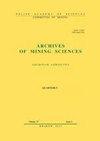矿区砌体结构技术磨损研究
IF 1.2
4区 工程技术
Q3 MINING & MINERAL PROCESSING
引用次数: 0
摘要
本文介绍了采动变形区砌体建筑技术磨损时间过程的评价研究结果。利用模糊推理系统(FIS)和“if-then”规则,将描述结构构件实际损伤的相应语言标签转换为描述建筑物损伤程度的标量输出。采用这种方法可以将开采引起的地面变形和砌体结构的自然磨损造成的额外影响分开。通过统计分析,建立了建筑物损伤状态的指数函数和自然磨损函数。这两种现象都是关于建筑结构技术时代的时间函数的研究对象。所得结果用于开发矿区传统建筑技术磨损过程的模型。在自然磨损过程中,矿区建筑物还面临着地面的强迫变形。这些作用引起结构构件内力的增加,产生了额外的应力因子和损伤。当采动效应强度值高于构件的抗应力强度值时,建筑结构构件就会出现发际裂缝和裂缝,反复作用导致结构刚度降低。对矿区建筑物行为的观察表明,采矿活动的强度及其影响的多样性在建筑物的技术磨损过程中起着重要作用。研究表明,与矿区外使用的类似建筑物相比,采矿效应造成的破坏程度加起来相当于建筑物的自然磨损,损害了整体技术状况。本文章由计算机程序翻译,如有差异,请以英文原文为准。
Studies of Masonry Structure Technical Wear in Mining Areas
The paper presents the results of assessment studies of the time course for technical wear in masonry buildings located in the area of mining-induced ground deformations. By using fuzzy inference system (FIS) and the “if-then” rule, corresponding language labels describing actual damage recorded in structure components were translated into scalar outputs describing the degree of damage to the building. Adopting this approach made it possible to separate damage resulting from additional effects coming from mining-induced ground deformations and the natural wear and tear of masonry structure. By using statistical analysis an exponential function for the condition of building damage and the function of natural wear and tear were developed. Both phenomena were subject to studies as a function of time regarding the technical age of building structure. The results obtained were used to develop a model for the course of technical wear of traditionally constructed buildings used within mining areas. In the course of natural wear and tear buildings located in mining areas are additionally exposed to forced ground deformations. The increase of internal forces in structure components induced by those effects results in creating an additional stress factor and damage. The hairline cracks and cracks of building structure components take place when the intensity value of mining effects becomes higher than the component stress resistance and repeated effects result in the decrease of structure rigidity. The observations of building behaviour in mining areas show that the intensity of mining activity and the multiplicity of its effect play a substantial role in the course of technical wear of buildings. The studies show that the level of damage resulting from mining effects adds up to natural wear and tear of the building and impairs the global technical condition as compared to similar buildings used outside mining areas.
求助全文
通过发布文献求助,成功后即可免费获取论文全文。
去求助
来源期刊

Archives of Mining Sciences
工程技术-矿业与矿物加工
CiteScore
2.40
自引率
16.70%
发文量
0
审稿时长
20 months
期刊介绍:
Archives of Mining Sciences (AMS) is concerned with original research, new developments and case studies in mining sciences and energy, civil engineering and environmental engineering. The journal provides an international forum for the publication of high quality research results in:
mining technologies,
mineral processing,
stability of mine workings,
mining machine science,
ventilation systems,
rock mechanics,
termodynamics,
underground storage of oil and gas,
mining and engineering geology,
geotechnical engineering,
tunnelling,
design and construction of tunnels,
design and construction on mining areas,
mining geodesy,
environmental protection in mining,
revitalisation of postindustrial areas.
Papers are welcomed on all relevant topics and especially on theoretical developments, analytical methods, numerical methods, rock testing, site investigation, and case studies.
 求助内容:
求助内容: 应助结果提醒方式:
应助结果提醒方式:


